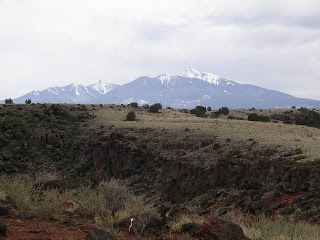This area has seen several cultures come and go, this was the frontier of between three groups defined by archeologists at Singua, Cohonina and the Kayenta.
The citadel is located right on the park road and it located high atop a rocky crag. It certainly looks like it was built for defensive purposes but no one really knows for sure. There is a fairly nice (gravel) trail to the top of the citadel allowing for some magnificent views from the top. From there you are able to see eight other pueblos (we could make out 5, maybe six if we used our imagination). At the base of the Citadel is the ruins of the Nalakihu Pueblo.
The Citadel

View of the inside of the Citadel

View from the Citadel of the San Francisco Mtns

View of the Jeep and the Nalakihu Pueblo
from top of the Citadel

View of the Citadel from Nalakihu Pueblo
 Wupatki is really an amazing site to behold. It is built utilizing an existing boulder as part of the structure of the pueblo. At this pueblo, there as been some reconstruction, but some they removed to make it more true to how they found it. The ball-court and ceremonial ring have both been reconstructed.
Wupatki is really an amazing site to behold. It is built utilizing an existing boulder as part of the structure of the pueblo. At this pueblo, there as been some reconstruction, but some they removed to make it more true to how they found it. The ball-court and ceremonial ring have both been reconstructed. Wupatki is derived from Hopi words that translate literally into "it was cut along" and recalls events in Hope clan history. The story goes, "that people prospered here. In time men began to gamble and ignored their crops and prayers for rain. Concerned, their leader severed a ritual object and then went into exile. When he returned the people awoke from their decadence." knowledgeable Hopis feel the proper place name of this area is Nuvaovi (the place of the snow) and the site known today as Wukoki was Wupatki. (from the Wupatki Pueblo trail guide)
Wupatki stood three stories high in places, double walls were filled with debris as a core and the roofs were constructed with timbers, cross-laid with smaller beams or reeds. Access was through roof openings.
Ball courts in the Southwest (I have only heard of them in the far south, like Chitzen Itza in Mexico... who knew we had them here too?) were not made of masonry, setting this one at Wupatki apart from others. Speculation is that it could have been used for a variety of activities such as ceremonies, competitive games, and even perhaps as a reservoir after rains.
Near the ball-court is a natural phenomenon called a blow-hole. I can't remember all the technical stuff that makes it works but basically it has to do with airflow and/or negative airflow. At any rate, me and the little boy that was visiting with his dad got a kick out of watching his dad's cap float in the air above the hole.
Nearby Sunset Crater last erupted sometime between 1040 and 1100 AD. Wupatki was settled soon after but it is uncertain if there is a direct cause and effect.













No comments:
Post a Comment